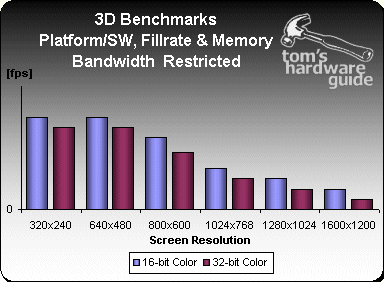3D Benchmarking - Understanding Frame Rate Scores
Summary

The chart above pretty much shows how an average 3D game benchmark chart would look. In the low resolutions the platform is limiting the frame rate, keeping the line flat in this area. Then at 16-bit color the fill rate limitation comes in and at higher resolutions the frame rate gets another hit by the memory bandwidth limitation. The scores at 32-bit color are lower than the 16-bit color scores. At low resolutions the difference is only small and at higher resolutions the frame rates at 32-bit color are only half of the scores at 16-bit color. The 3D-chip is never quite able to deliver its theoretical fill rate maximum. At low resolutions it's limited by the platform performance, waiting for the CPU to deliver the 3D-data and at high resolutions the memory bandwidth limitation makes high fill rates impossible.
The Future ..?
Future 3D-chips need much faster memory interfaces if we want high frame rates at high resolutions or full scene antialiasing. A chip that can render 2 Gpixel/s will be stalled permanently if it doesn't get a memory bandwidth of at least 12 GB/s. The alternatives are solutions that decrease the requirements for memory bandwidth, as e.g. Ati's 'hyper-Z' technology in the upcoming 'Radeon' chip. Besides that, faster platforms with faster processors, faster memory (please no RDRAM!) and faster AGP will help a lot too. However, more memory bandwidth is the most important requirement for future 3D-solutions.
Stay on the Cutting Edge
Join the experts who read Tom's Hardware for the inside track on enthusiast PC tech news — and have for over 25 years. We'll send breaking news and in-depth reviews of CPUs, GPUs, AI, maker hardware and more straight to your inbox.
Most Popular

